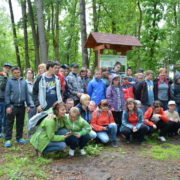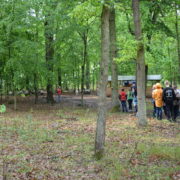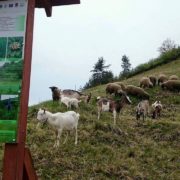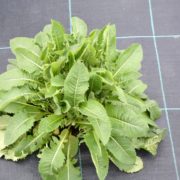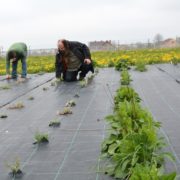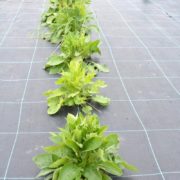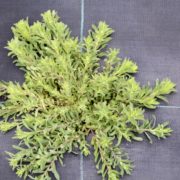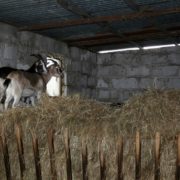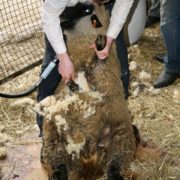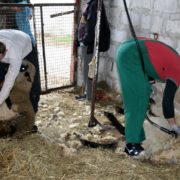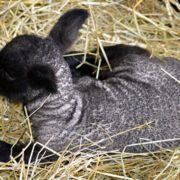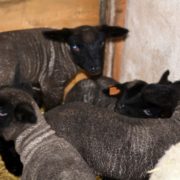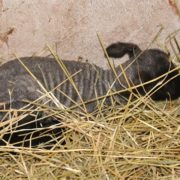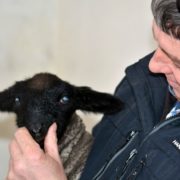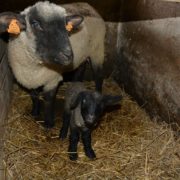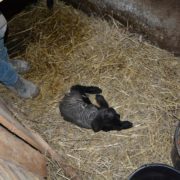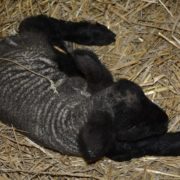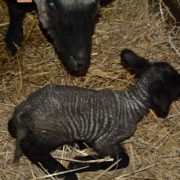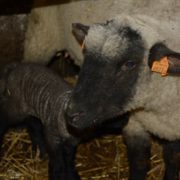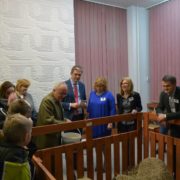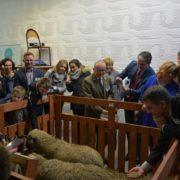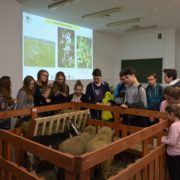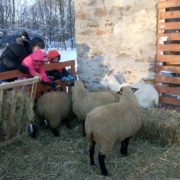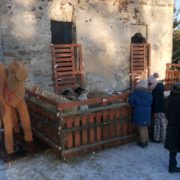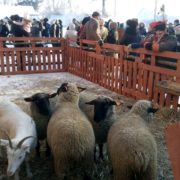News
A visit of scientists
We had guests in the habitats where the pasturing is carried out: four scientists from the Department of Small Ruminants Breeding and Agricultural Consultancy at the University of Life Sciences in Lublin, together with the Head of the Department, Prof. Tomasz Gruszecki, Ph.D. The scientists watched sheep grazing in Stawiany and Wola Chroberska and in the Quercetalia pubescenti-petraeae area in Młodzawy. In their opinion, the sheep were in very good condition, which referred to both the ones in the pastures and mothers that were still staying with their young in sheepfolds. It was also an opportunity to discuss the rules of future cooperation with the University of Life Sciences, as the scientists were interested in conducting comparative research on flocks pastured in different conditions – in the forest and on xerothermic grasslands.
An educational workshops
Nearly 400 people participated in an educational workshop we organized from the 18th to 26th of May. Young people from schools in Kielce and Busko Zdrój took part in field classes in Młodzawy and at Garb Pińczowski, and in classes conducted in small groups in the headquarters of the Landscape Park Complex of the Świętokrzyskie and Nadnidziańskie Regions in Krzyżanowice Średnie.
In the open air, young people could watch the pasturing in two different habitats: xerothermic grasslands and Quercetalia pubescenti-petraeae areas, and identify protected plants both in the natural environment and on our plantation established in Krzyżanowice near the headquarters.
The practical work began with a lecture on the history of Ponidzie; the history dating back to 14 million years ago when the Himalayas, the Alps and the Carpathians had been rising up, and limestone and gypsum had been forming deposits in the warm sea of the Precarpathian Depression. During the workshop the participants could also try their hands at needlework, making decorative woven bands on bardko and plates, or making pompons.
It was already the fourth edition of our workshop. And altogether, more than 1,300 people took part in it.
They went to the grasslands
Not hounds, like in the Żeromski’s novel, but sheep and goats started another busy season at the Ponidzie region.
Right up until the late autumn they will be eating up grass in the xerothermic plant groups in order to disable the succession of undesired plants and restore the natural appearance of the Ponidzie hills.
This year, due to the cool weather, the pasturing season is visibly delayed, but we hope that our “living mowers” will make up for lost time and the pastures near the Nida River will be restored to their former glory.
Spring on the plantation.
In spite of the cool weather, the spring has finally come to our plantation in Krzyżanowice. The row of Serratula lycopifolia looks the most impressive. Some of them have already had buds. No wonder, as they should bloom in a few weeks, in June. The growth of Carlina onopordifolia Besser started at the very end. We were even afraid that the seedlings had been damaged by frosts, but between last year’s dry leaves young green ones appeared.
Thanks to using agrotextiles, the spring weeding was limited to the removing of several clumps of grass.
With the camera among the sheeps.
In a few weeks, when the grasslands become green, we will take our sheep to the Ponidzie pastures. Our flock became famous at the Ponidzie region, and it is going to be even more famous, because we were visited by a TVP crew so that they could film young blackhead sheep. In the sheepfolds, where our sheep had spent the winter, the lambing was still in progress. Young sheep, tame and gentle, were not afraid of the camera. They allowed people to stroke and pick them up. Their mothers, however, were not so much delighted and they protested bleating loudly. The oldest, four-week young sheep, for which there is less and less milk, have already eaten hay and they will be soon ready to go outside to eat fresh grass.
TVP Kielce material: https://kielce.tvp.pl/29970717/czas-barankow
Shearing.
For our flock it was the first meeting with shears, or a shearing device. No wonder our sheep prudently hid in a safe place behind a straw barricade, sending curious goats to check what was going on. However, when they went to the ‘hairdressing armchair’ one by one, they were quite calm. The shearing does not last long; an experienced shearer needs a few minutes at the most for this. There are even world championships in this field. The best shearers can shear even 700 sheep in 8 hours, that is, 1.5 sheep per minute, and in New Zealand sheep shearing has even been a national sport since 1994.
Blackhead sheep are universal sheep raised for meat and just for wool. The shearing takes place once or twice a year, depending on the purpose of the wool. The growth of wool during a year is about 10 centimetres, and you get about 4 kg of fleece from one sheep.
Several kilograms lighter and deprived of wool, the sheep seemed quite surprised, but they quickly got used to the new situation. Anyway, they still had a few weeks before the herding, which is taking sheep to summer pastures, and their wool would grow a bit until then.
Lambing in the flocks is in progress
Lambing in the flocks is in progress. According to the last report, we have already had 40 young sheep. In spite of receiving many proposals to sell lambs, all our breeders declare that they are not going to get rid of the offspring and will increase their flocks. So there is a good chance of reviving sheep breeding traditions at Ponidzie after so many years, especially as we are receiving many reports of farmers declaring their willingness to start sheep breeding on their farms. This pleases us and clearly demonstrates that the seeds sown by us start bearing fruit. All for the benefit of nature and certainly for the farmers’ pockets.
We have the first baby sheep
We have the first baby sheep in the LIFE + programme. At night, from Wednesday to Thursday, on the 23rd of February 2017, the first sheep was born at Michał Dobaj’s farm in Wola Chroberska. The first birth had been awaited long, and anxiously, by Mr Michał. As he told us, he had been on duty all night long and at 5 am, when he was exhausted and went to sleep, the little sheep decided that it was the right time. So it was born without the farmer’s assistance.
Now we are looking forward to new births on the other farms covered by the programme.
Last-minute news!!!
We have more baby sheep.
This time on Monday, 27th of February 2017, two lambs were born at Waldemar Siepracki’s farm in Stawiany in the Kije district. In the pictures, you can see the first baby sheep from Wola Chroberska with its mom.
The Night of Biologists 2017
The Night of Biologists on Friday, January 13th, was an all-Poland event. The Jan Kochanowski University in Kielce was among the twenty one schools and universities that opened their rooms for thousands of visitors. Therefore, we also turned up there with our blackhead sheep, at the Faculty of Mathematics and Science. We set up an enclosure in one of the rooms, spread straw on the floor and filled the feeding rack with hay. Two sheep and two goats promoted the LIFE + project till late in the evening.
The living animals aroused curiosity. Although they were reluctant to be stroked, they could be fed, which was a great attraction not only for the youngest visitors. And we could inform them about how sheep contributed to the maintenance of the biodiversity of these habitats, thanks to pasturage on xerothermic grasslands and in Quercetalia pubescenti-petraeae areas. Our participation in the Night of Biologists also was an opportunity to promote sheep breeding and its benefits. We hope that in spring our flock will significantly grow. We will also visit another edition of the Night of Biologists. So see you there.
The Procession of the Three Kings in Samsonów
On the 6th of January, the sheep, which had been helping us with the LIFE+ project for almost a year, took part in the traditional Procession of the Three Kings w Samsonów. This year’s edition proceeded according to a new script, as apart from pantomime scenes performed by middle school pupils, the event also included the nativity scene, located among the picturesque ruins of a large blast furnace, which is part of the wider Old Polish Industrial Region complex.
In spite of biting frost, which the sheep endured easily, there were a lot of participants. The animals were the greatest attraction, especially for the youngest participants.
The Procession of the Three Kings was an opportunity to promote the LIFE+ project not only in the northern part of the region, but also throughout Poland, because, among one of the three processions in the whole country, it was chosen by TVP for live broadcast.













